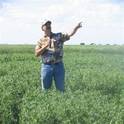
Presentation
Sheep Grazing Wheat Summer Fallow and the Impact on Soil Nitrogen, Moisture, and Crop Yield
Western Section, American Society of Animal Science
(2007)
Abstract
In typical dryland farming areas of Montana, annual precipitation is not sufficient for annual harvest of small grains. Summer fallow in alternate years, is a common method of conserving soil moisture to produce a crop in the following season. Current methods of fallow management are primarily mechanical tillage and spraying with herbicides. Although these methods are effective, they are expensive, making fallow management the highest variable cost associated with dryland grain production. The objectives of this study were to compare the impact of grazing small grains stubble with sheep, as a fallow management tactic, against traditional management practices of chemical and mechanical fallow across two cropping systems on wheat grain yield, and soil nitrate-nitrogen and moisture.
Keywords
- small ruminant,
- grain yield,
- sustainable agriculture,
- cereal stubble,
- soil
Disciplines
Publication Date
2007
Comments
Works produced by employees of the U.S. Government as part of their official duties are not copyrighted within the U.S. The content of this document is not copyrighted.
Citation Information
Andrew W. Lenssen, E. E. Snyder, H. B. Goosey and P. G. Hatfield. "Sheep Grazing Wheat Summer Fallow and the Impact on Soil Nitrogen, Moisture, and Crop Yield" Western Section, American Society of Animal Science (2007) Available at: http://works.bepress.com/andrew_lenssen/74/
